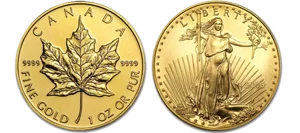Silver vs. Gold: Comparing the Two Most Popular Precious Metals
Disclosure: We are reader-supported. If you purchase from a link on our site, we may earn a commission. Learn more
Last Updated on: 30th June 2023, 06:54 pm
Gold and silver have been a beacon of stability for investors seeking to diversify their portfolios in an unpredictable economic landscape. In fact, the two most popular precious metals are often the go-to options for those considering a rollover from their Individual Retirement Accounts (IRAs) or 401k into precious metals. This article compares silver vs gold from an investment perspective, highlighting their unique characteristics, performance, and suitability for different investment goals.
| Factors | Gold | Silver |
|---|---|---|
| Price Volatility | Generally stable | More volatile |
| Market Size | Larger, more liquid market | Smaller market |
| Price Point | Higher price per ounce, can be costly for small investors | Lower price per ounce, accessible for small investors |
| Economic Uncertainty Performance | Often performs well as a ‘safe haven' asset | Mixed performance due to industrial demand |
| Industrial Use | Limited industrial uses, mostly investment and jewelry | Widespread industrial uses in addition to investment |
| Portfolio Diversification | Reliable for wealth preservation | Useful for both growth and wealth preservation |
| IRA Option | Gold IRAs are popular | Silver IRAs are gaining popularity |
Gold has been a symbol of wealth and stability for centuries. As a tangible asset that retains its value over time, gold provides a hedge against inflation, currency depreciation, and economic instability. Its rarity, coupled with its use in industries like electronics and dentistry, ensures a steady demand that underpins its value.
Silver, on the other hand, although often seen as gold's less glamorous sibling, holds substantial appeal for investors. It's not only a store of wealth but also an industrial metal with widespread applications in sectors like electronics, medicine, and renewable energy. This dual demand — investment and industrial — can influence silver's price dynamics.
Table of Contents
Precious Metals Price Volatility
While both gold and silver can be volatile, silver tends to experience more price fluctuations. This volatility can present opportunities for high returns, though it comes with increased risk. Gold prices, by contrast, are generally more stable, making gold a preferred choice for conservative investors seeking steady wealth preservation.
Gold vs Silver – Industrial Uses
Gold and silver are not only valued for their aesthetics and rarity, but they also have important industrial applications due to their unique properties. Here's a brief overview of their main uses:
Gold
- Electronics: Due to its excellent conductivity and resistance to corrosion, gold is often used in connectors, switch and relay contacts, soldered joints, connecting wires, and connection strips.
- Dentistry and Medicine: Gold has been used in dentistry for thousands of years due to its non-allergenic properties and the ease with which it can be shaped. In medicine, it is used in diagnostic procedures and certain treatment.
- Aerospace: The aerospace industry uses gold in many equipment parts due to its ability to conduct electricity, resist corrosion, and remain stable under harsh conditions.
Silver
- Electronics: Like gold, silver also has excellent conductivity. It is widely used in printed circuit boards, RF connectors, membrane switches, RFID tags, and other electronic components.
- Photography: Silver compounds, such as silver nitrate and silver halide, have been widely used in photographic films and papers, although this usage has declined with the rise of digital photography.
- Solar Energy: Silver paste is used in photovoltaic solar cells. It plays a crucial role in conducting electricity produced by the photovoltaic effect in solar panels.
- Medicine: Silver has antibacterial properties and is used in a range of medical applications, including wound dressings, and medical equipment.
These are just some of the uses of gold and silver in industries. However, it's important to note that while both metals are used in industries, the demand is much higher for silver due to its wider range of applications.
Market Size and Liquidity
The gold market is significantly larger and more liquid than the silver market, which can influence price stability and the ease of buying and selling. For large-scale investors, gold's liquidity can be particularly beneficial. However, silver's smaller market size and lower price per ounce can offer a more accessible entry point for small-scale investors.
Performance During Economic Uncertainty
Gold typically shines during times of economic uncertainty, acting as a ‘safe haven' asset. Investors flock to gold in times of market turmoil, leading to price increases. Silver, while also benefiting from uncertain economic times, has a stronger correlation to economic activity due to its industrial uses. Thus, its performance can be more mixed, rising during economic booms but also experiencing substantial increases during downturns when it's viewed as a safe store of value.
Portfolio Diversification
Diversifying your portfolio with both gold and silver can help spread risk. While the two metals often move in the same general direction, they don't move identically. They react differently to market conditions due to their distinct industrial uses and demand dynamics. By holding both, you can potentially offset losses in one with gains in the other.
Gold vs Silver IRAs
If you're considering rolling over part of your IRA or 401k into precious metals, both gold and silver offer IRS-approved options. Both metals need to meet certain purity standards to be included in a Precious Metals IRA.
While Gold IRAs have been popular for some time, Silver IRAs are gaining traction due to silver's potential for growth and its lower entry price. It's worth noting that precious metals stored in an IRA must be kept by a custodian, with specific storage requirements.
Conclusion
Gold and silver, each with its unique advantages and risks, serve different investment objectives. Gold, with its stability and status as a safe haven, is suitable for those seeking wealth preservation. Silver, with its volatility and industrial demand, presents opportunities for both growth and wealth preservation.
While the choice between gold and silver ultimately depends on your individual financial goals and risk tolerance, diversifying your portfolio with a mix of both could potentially offer the best of both worlds. As always, it's wise to seek advice from a financial advisor before making significant changes to your investment portfolio.



 Silver
Silver Gold
Gold Platinum
Platinum Palladium
Palladium Bitcoin
Bitcoin Ethereum
Ethereum

 Gold: $3,329.37
Gold: $3,329.37
 Silver: $36.85
Silver: $36.85
 Platinum: $1,380.82
Platinum: $1,380.82
 Palladium: $1,143.38
Palladium: $1,143.38
 Bitcoin: $109,622.77
Bitcoin: $109,622.77
 Ethereum: $2,590.46
Ethereum: $2,590.46